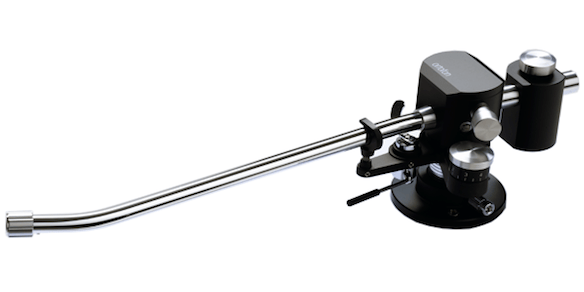The tonearm is the mechanism on a turntable that conveys the cartridge that telegraphs the vibrations from a vinyl album into electrical signals through the stylus, or needle. A tonearm is usually a counterbalanced lever working from a pivot, but there are also linear tracking turntables, whereby the cartridge rides on a straight beam, setting the stylus on the optimum point of geometric tangency on the record.

Image credit: Ortofon.
There are a number of physics forces one can study in how a tonearm places the Stylus on an album. One is the outward centrifugal force caused by the fact that the record is revolving. Another is the force with which the stylus bears on the record, as too much pressure can not only cause deterioration of the recorded information etched into its surface, but also convey the vibrations from the motor into the signal path, where they are amplified and manifest in the playback as distortion. Too little pressure fails to pick up the more delicate details in a piece of music and falls short of expectations of accuracy.
The geometry of how the stylus lands on the record is of paramount importance. The stylus ideally strikes the record at a point perpendicular (90 degrees) to a line drawn between the center of the record and a point on its circumference, or perimeter. We’ll call this line a radian. Considering the clockwise direction of rotation on a turntable, if the tip of the stylus lands on the record before or after that point, it lands eccentrically in the groove where the music is etched, and thus strikes the right or left side of the groove, corrupting the reading of the information to be played.
To consider the point from which a tonearm can land the stylus in the outermost ring of a record, then track to the interior, and still strike from a perpendicular position, is to define a perfect point from which the tonearm must pivot. Perfection is difficult to manufacture.
Thus the design of the linear tracking turntable, where an entire article could be dedicated to Bang and Olufsen Turntables, attempts to solve this problem of geometry by suspending a beam over the radian, and running the cartridge down the beam. This eliminates finding a geometric point from which the tonearm pivots and theoretically balances the stylus in the groove symmetrically, avoiding distortion that arises from eccentricity mentioned before.
One drawback to linear tracking tonearms is that a secondary mechanical system had to be introduced to transport the cartridge down the beam. This was solved by introducing a micro-servo-motor, which would use a gear to drive the cartridge mechanism down the beam. The servo-motor acted intermittently rather than constantly, and listeners who qualify as “Golden Ears” could actually hear the interference caused when the motor engaged, presenting noise in the final playback.
It can be difficult to find product availability for traditional tonearms, as they tend to be sold with turntables. A good example of high-end audiophile gear is the Kuzma Stabi XL4 turntable and Air Line Tonearm. This is a $28,500 system. The Walker Proscenium Black Diamond is available for $40,000.



